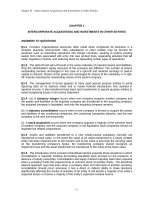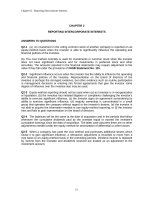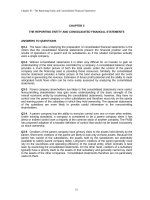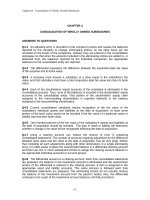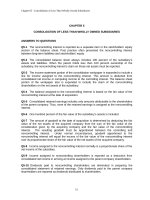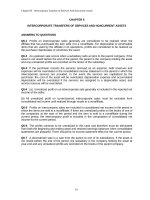Solution manual mechanics of materials 8th edition hibbeler chapter 02
Bạn đang xem bản rút gọn của tài liệu. Xem và tải ngay bản đầy đủ của tài liệu tại đây (1.56 MB, 20 trang )
02 Solutions 46060
5/6/10
1:45 PM
Page 1
© 2010 Pearson Education, Inc., Upper Saddle River, NJ. All rights reserved. This material is protected under all copyright laws as they currently
exist. No portion of this material may be reproduced, in any form or by any means, without permission in writing from the publisher.
2–1. An air-filled rubber ball has a diameter of 6 in. If
the air pressure within it is increased until the ball’s
diameter becomes 7 in., determine the average normal
strain in the rubber.
d0 = 6 in.
d = 7 in.
e =
pd - pd0
7 - 6
=
= 0.167 in./in.
pd0
6
Ans.
2–2. A thin strip of rubber has an unstretched length of
15 in. If it is stretched around a pipe having an outer diameter
of 5 in., determine the average normal strain in the strip.
L0 = 15 in.
L = p(5 in.)
e =
L - L0
5p - 15
=
= 0.0472 in.>in.
L0
15
Ans.
2–3. The rigid beam is supported by a pin at A and wires
BD and CE. If the load P on the beam causes the end C to
be displaced 10 mm downward, determine the normal strain
developed in wires CE and BD.
D
E
4m
P
¢LBD
¢LCE
=
3
7
A
3 (10)
= 4.286 mm
7
¢LCE
10
=
=
= 0.00250 mm>mm
L
4000
3m
¢LBD =
eCE
eBD =
B
Ans.
¢LBD
4.286
=
= 0.00107 mm>mm
L
4000
Ans.
1
C
2m
2m
02 Solutions 46060
5/6/10
1:45 PM
Page 2
© 2010 Pearson Education, Inc., Upper Saddle River, NJ. All rights reserved. This material is protected under all copyright laws as they currently
exist. No portion of this material may be reproduced, in any form or by any means, without permission in writing from the publisher.
*2–4. The two wires are connected together at A. If the
force P causes point A to be displaced horizontally 2 mm,
determine the normal strain developed in each wire.
C
300
œ
= 23002 + 22 - 2(300)(2) cos 150° = 301.734 mm
LAC
eAC = eAB
œ
- LAC
LAC
301.734 - 300
=
=
= 0.00578 mm>mm
LAC
300
mm
30Њ
Ans.
30Њ
300
A
P
mm
B
•2–5. The rigid beam is supported by a pin at A and wires
BD and CE. If the distributed load causes the end C to be
displaced 10 mm downward, determine the normal strain
developed in wires CE and BD.
E
D
2m
1.5 m
3m
2m
A
B
C
w
Since the vertical displacement of end C is small compared to the length of member
AC, the vertical displacement dB of point B, can be approximated by referring to the
similar triangle shown in Fig. a
dB
10
=
;
dB = 4 mm
2
5
The unstretched lengths of wires BD and CE are LBD = 1500 mm and
LCE = 2000 mm.
dB
4
Ans.
=
= 0.00267 mm>mm
A eavg B BD =
LBD
1500
A eavg B CE =
dC
10
=
= 0.005 mm>mm
LCE
2000
Ans.
2
02 Solutions 46060
5/6/10
1:45 PM
Page 3
© 2010 Pearson Education, Inc., Upper Saddle River, NJ. All rights reserved. This material is protected under all copyright laws as they currently
exist. No portion of this material may be reproduced, in any form or by any means, without permission in writing from the publisher.
2–6. Nylon strips are fused to glass plates. When
moderately heated the nylon will become soft while the
glass stays approximately rigid. Determine the average
shear strain in the nylon due to the load P when the
assembly deforms as indicated.
y
2 mm
P
3 mm
5 mm
3 mm
5 mm
3 mm
g = tan - 1 a
2
b = 11.31° = 0.197 rad
10
x
Ans.
2–7. If the unstretched length of the bowstring is 35.5 in.,
determine the average normal strain in the string when it is
stretched to the position shown.
18 in.
6 in.
18 in.
Geometry: Referring to Fig. a, the stretched length of the string is
L = 2L¿ = 2 2182 + 62 = 37.947 in.
Average Normal Strain:
eavg =
L - L0
37.947 - 35.5
=
= 0.0689 in.>in.
L0
35.5
Ans.
3
02 Solutions 46060
5/6/10
1:45 PM
Page 4
© 2010 Pearson Education, Inc., Upper Saddle River, NJ. All rights reserved. This material is protected under all copyright laws as they currently
exist. No portion of this material may be reproduced, in any form or by any means, without permission in writing from the publisher.
u
*2–8. Part of a control linkage for an airplane consists of a
rigid member CBD and a flexible cable AB. If a force is
applied to the end D of the member and causes it to rotate
by u = 0.3°, determine the normal strain in the cable.
Originally the cable is unstretched.
D
P
300 mm
B
AB = 24002 + 3002 = 500 mm
300 mm
AB¿ = 2400 + 300 - 2(400)(300) cos 90.3°
2
2
A
C
= 501.255 mm
eAB =
AB¿ - AB
501.255 - 500
=
AB
500
400 mm
= 0.00251 mm>mm
Ans.
•2–9.
Part of a control linkage for an airplane consists
of a rigid member CBD and a flexible cable AB. If a force is
applied to the end D of the member and causes a normal
strain in the cable of 0.0035 mm>mm, determine the
displacement of point D. Originally the cable is unstretched.
u
D
300 mm
B
AB = 23002 + 4002 = 500 mm
300 mm
AB¿ = AB + eABAB
A
= 500 + 0.0035(500) = 501.75 mm
C
501.752 = 3002 + 4002 - 2(300)(400) cos a
a = 90.4185°
400 mm
p
(0.4185) rad
u = 90.4185° - 90° = 0.4185° =
180°
¢ D = 600(u) = 600(
P
p
)(0.4185) = 4.38 mm
180°
Ans.
4
02 Solutions 46060
5/6/10
1:45 PM
Page 5
© 2010 Pearson Education, Inc., Upper Saddle River, NJ. All rights reserved. This material is protected under all copyright laws as they currently
exist. No portion of this material may be reproduced, in any form or by any means, without permission in writing from the publisher.
2–10. The corners B and D of the square plate are given
the displacements indicated. Determine the shear strains at
A and B.
y
A
16 mm
D
B
3 mm
3 mm 16 mm
16 mm
Applying trigonometry to Fig. a
f = tan - 1 a
13
p rad
b = 39.09° a
b = 0.6823 rad
16
180°
a = tan - 1 a
16
p rad
b = 50.91° a
b = 0.8885 rad
13
180°
By the definition of shear strain,
A gxy B A =
p
p
- 2f =
- 2(0.6823) = 0.206 rad
2
2
Ans.
A gxy B B =
p
p
- 2a =
- 2(0.8885) = -0.206 rad
2
2
Ans.
5
C
16 mm
x
02 Solutions 46060
5/6/10
1:45 PM
Page 6
© 2010 Pearson Education, Inc., Upper Saddle River, NJ. All rights reserved. This material is protected under all copyright laws as they currently
exist. No portion of this material may be reproduced, in any form or by any means, without permission in writing from the publisher.
2–11. The corners B and D of the square plate are given
the displacements indicated. Determine the average normal
strains along side AB and diagonal DB.
y
A
16 mm
D
B
3 mm
3 mm 16 mm
16 mm
Referring to Fig. a,
LAB = 2162 + 162 = 2512 mm
LAB¿ = 2162 + 132 = 2425 mm
LBD = 16 + 16 = 32 mm
LB¿D¿ = 13 + 13 = 26 mm
Thus,
A eavg B AB =
LAB¿ - LAB
2425 - 2512
=
= -0.0889 mm>mm
LAB
2512
Ans.
A eavg B BD =
LB¿D¿ - LBD
26 - 32
=
= -0.1875 mm>mm
LBD
32
Ans.
6
C
16 mm
x
02 Solutions 46060
5/6/10
1:45 PM
Page 7
© 2010 Pearson Education, Inc., Upper Saddle River, NJ. All rights reserved. This material is protected under all copyright laws as they currently
exist. No portion of this material may be reproduced, in any form or by any means, without permission in writing from the publisher.
*2–12. The piece of rubber is originally rectangular.
Determine the average shear strain gxy at A if the corners B
and D are subjected to the displacements that cause the
rubber to distort as shown by the dashed lines.
y
3 mm
C
D
2
= 0.006667 rad
300
3
u2 = tan u2 =
= 0.0075 rad
400
u1 = tan u1 =
400 mm
gxy = u1 + u2
A
= 0.006667 + 0.0075 = 0.0142 rad
Ans.
•2–13.
The piece of rubber is originally rectangular and
subjected to the deformation shown by the dashed lines.
Determine the average normal strain along the diagonal
DB and side AD.
f = tan
B
2 mm
3 mm
C
D
400 mm
3
b = 0.42971°
a
400
AB¿ = 2(300)2 + (2)2 = 300.00667
w = tan - 1 a
x
y
AD¿ = 2(400)2 + (3)2 = 400.01125 mm
-1
300 mm
A
2
b = 0.381966°
300
a = 90° - 0.42971° - 0.381966° = 89.18832°
D¿B¿ = 2(400.01125)2 + (300.00667)2 - 2(400.01125)(300.00667) cos (89.18832°)
D¿B¿ = 496.6014 mm
DB = 2(300)2 + (400)2 = 500 mm
496.6014 - 500
= -0.00680 mm>mm
500
400.01125 - 400
=
= 0.0281(10 - 3) mm>mm
400
eDB =
Ans.
eAD
Ans.
7
300 mm
B
2 mm
x
02 Solutions 46060
5/6/10
1:45 PM
Page 8
© 2010 Pearson Education, Inc., Upper Saddle River, NJ. All rights reserved. This material is protected under all copyright laws as they currently
exist. No portion of this material may be reproduced, in any form or by any means, without permission in writing from the publisher.
2–14. Two bars are used to support a load. When unloaded,
AB is 5 in. long, AC is 8 in. long, and the ring at A has
coordinates (0, 0). If a load P acts on the ring at A, the normal
strain in AB becomes PAB = 0.02 in.>in., and the normal
strain in AC becomes PAC = 0.035 in.>in. Determine the
coordinate position of the ring due to the load.
y
B
C
60Њ
5 in.
8 in.
A
x
P
Average Normal Strain:
œ
= LAB + eAB LAB = 5 + (0.02)(5) = 5.10 in.
LAB
œ
= LAC + eACLAC = 8 + (0.035)(8) = 8.28 in.
LAC
Geometry:
a = 282 - 4.33012 = 6.7268 in.
5.102 = 9.22682 + 8.282 - 2(9.2268)(8.28) cos u
u = 33.317°
x¿ = 8.28 cos 33.317° = 6.9191 in.
y¿ = 8.28 sin 33.317° = 4.5480 in.
x = -(x¿ - a)
= -(6.9191 - 6.7268) = -0.192 in.
Ans.
y = -(y¿ - 4.3301)
= -(4.5480 - 4.3301) = -0.218 in.
Ans.
8
02 Solutions 46060
5/6/10
1:45 PM
Page 9
© 2010 Pearson Education, Inc., Upper Saddle River, NJ. All rights reserved. This material is protected under all copyright laws as they currently
exist. No portion of this material may be reproduced, in any form or by any means, without permission in writing from the publisher.
2–15. Two bars are used to support a load P. When
unloaded, AB is 5 in. long, AC is 8 in. long, and the ring at A
has coordinates (0, 0). If a load is applied to the ring at A, so
that it moves it to the coordinate position (0.25 in.,
-0.73 in.), determine the normal strain in each bar.
y
B
C
60Њ
5 in.
8 in.
A
x
P
Geometry:
a = 282 - 4.33012 = 6.7268 in.
LA¿B = 2(2.5 + 0.25)2 + (4.3301 + 0.73)2
= 5.7591 in.
LA¿C = 2(6.7268 - 0.25)2 + (4.3301 + 0.73)2
= 8.2191 in.
Average Normal Strain:
eAB =
=
eAC =
=
LA¿B - LAB
LAB
5.7591 - 5
= 0.152 in.>in.
5
Ans.
LA¿C - LAC
LAC
8.2191 - 8
= 0.0274 in.>in.
8
Ans.
9
02 Solutions 46060
5/6/10
1:45 PM
Page 10
© 2010 Pearson Education, Inc., Upper Saddle River, NJ. All rights reserved. This material is protected under all copyright laws as they currently
exist. No portion of this material may be reproduced, in any form or by any means, without permission in writing from the publisher.
*2–16. The square deforms into the position shown by the
dashed lines. Determine the average normal strain along
each diagonal, AB and CD. Side D¿B¿ remains horizontal.
y
3 mm
D¿
B¿
B
D
Geometry:
AB = CD = 2502 + 502 = 70.7107 mm
53 mm
C¿D¿ = 2532 + 582 - 2(53)(58) cos 91.5°
50 mm
91.5Њ
= 79.5860 mm
C
B¿D¿ = 50 + 53 sin 1.5° - 3 = 48.3874 mm
A
x
C¿
AB¿ = 2532 + 48.38742 - 2(53)(48.3874) cos 88.5°
50 mm
8 mm
= 70.8243 mm
Average Normal Strain:
eAB =
=
eCD =
=
AB¿ - AB
AB
70.8243 - 70.7107
= 1.61 A 10 - 3 B mm>mm
70.7107
Ans.
C¿D¿ - CD
CD
79.5860 - 70.7107
= 126 A 10 - 3 B mm>mm
70.7107
Ans.
•2–17.
The three cords are attached to the ring at B. When
a force is applied to the ring it moves it to point B¿ , such
that the normal strain in AB is PAB and the normal strain in
CB is PCB. Provided these strains are small, determine the
normal strain in DB. Note that AB and CB remain
horizontal and vertical, respectively, due to the roller guides
at A and C.
A¿
B¿
A
B
L
Coordinates of B (L cos u, L sin u)
u
Coordinates of B¿ (L cos u + eAB L cos u, L sin u + eCB L sin u)
C¿
D
LDB¿ = 2(L cos u + eAB L cos u) + (L sin u + eCB L sin u)
2
2
LDB¿ = L 2cos2 u(1 + 2eAB + e2AB) + sin2 u(1 + 2eCB + e2CB)
Since eAB and eCB are small,
LDB¿ = L 21 + (2 eAB cos2 u + 2eCB sin2 u)
Use the binomial theorem,
LDB¿ = L ( 1 +
1
(2 eAB cos2 u + 2eCB sin2 u))
2
= L ( 1 + eAB cos2 u + eCB sin2 u)
Thus, eDB =
L( 1 + eAB cos2 u + eCB sin2 u) - L
L
eDB = eAB cos2 u + eCB sin2 u
Ans.
10
C
02 Solutions 46060
5/6/10
1:45 PM
Page 11
© 2010 Pearson Education, Inc., Upper Saddle River, NJ. All rights reserved. This material is protected under all copyright laws as they currently
exist. No portion of this material may be reproduced, in any form or by any means, without permission in writing from the publisher.
2–18. The piece of plastic is originally rectangular.
Determine the shear strain gxy at corners A and B if the
plastic distorts as shown by the dashed lines.
y
5 mm
2 mm
2 mm
B
4 mm
C
300 mm
Geometry: For small angles,
2 mm
D
2
a = c =
= 0.00662252 rad
302
b = u =
A
x
400 mm
3 mm
2
= 0.00496278 rad
403
Shear Strain:
(gB)xy = a + b
= 0.0116 rad = 11.6 A 10 - 3 B rad
Ans.
(gA)xy = -(u + c)
= -0.0116 rad = -11.6 A 10 - 3 B rad
Ans.
2–19. The piece of plastic is originally rectangular.
Determine the shear strain gxy at corners D and C if the
plastic distorts as shown by the dashed lines.
y
5 mm
2 mm
2 mm
B
4 mm
C
300 mm
2 mm
D
A
400 mm
3 mm
Geometry: For small angles,
2
= 0.00496278 rad
403
2
= 0.00662252 rad
b = u =
302
Shear Strain:
a = c =
(gC)xy = -(a + b)
= -0.0116 rad = -11.6 A 10 - 3 B rad
Ans.
(gD)xy = u + c
= 0.0116 rad = 11.6 A 10 - 3 B rad
Ans.
11
x
02 Solutions 46060
5/6/10
1:45 PM
Page 12
© 2010 Pearson Education, Inc., Upper Saddle River, NJ. All rights reserved. This material is protected under all copyright laws as they currently
exist. No portion of this material may be reproduced, in any form or by any means, without permission in writing from the publisher.
*2–20. The piece of plastic is originally rectangular.
Determine the average normal strain that occurs along the
diagonals AC and DB.
y
5 mm
2 mm
2 mm
Geometry:
B
4 mm
C
AC = DB = 24002 + 3002 = 500 mm
300 mm
DB¿ = 24052 + 3042 = 506.4 mm
2 mm
D
A¿C¿ = 2401 + 300 = 500.8 mm
2
2
x
A
400 mm
3 mm
Average Normal Strain:
eAC =
A¿C¿ - AC
500.8 - 500
=
AC
500
= 0.00160 mm>mm = 1.60 A 10 - 3 B mm>mm
eDB =
Ans.
DB¿ - DB
506.4 - 500
=
DB
500
= 0.0128 mm>mm = 12.8 A 10 - 3 B mm>mm
Ans.
•2–21.
The force applied to the handle of the rigid lever
arm causes the arm to rotate clockwise through an angle of
3° about pin A. Determine the average normal strain
developed in the wire. Originally, the wire is unstretched.
D
600 mm
Geometry: Referring to Fig. a, the stretched length of LB¿D can be determined using
the consine law,
A
LB¿D = 2(0.6 cos 45°)2 + (0.6 sin 45°)2 - 2(0.6 cos 45°)(0.6 sin 45°) cos 93°
B
= 0.6155 m
Average Normal Strain: The unstretched length of wire BD is LBD = 0.6 m. We
obtain
eavg =
C
45Њ
LB¿D - LBD
0.6155 - 0.6
= 0.0258 m>m
=
LBD
0.6
Ans.
12
02 Solutions 46060
5/6/10
1:45 PM
Page 13
© 2010 Pearson Education, Inc., Upper Saddle River, NJ. All rights reserved. This material is protected under all copyright laws as they currently
exist. No portion of this material may be reproduced, in any form or by any means, without permission in writing from the publisher.
2–22. A square piece of material is deformed into the
dashed position. Determine the shear strain gxy at A.
y
15.18 mm
B
Shear Strain:
(gA)xy =
89.7°
p
- ¢
≤p
2
180°
C
15.24 mm
15 mm
= 5.24 A 10 - 3 B rad
Ans.
89.7Њ
A
2–23. A square piece of material is deformed into the
dashed parallelogram. Determine the average normal strain
that occurs along the diagonals AC and BD.
15 mm
15.18 mm
x
D
y
15.18 mm
B
C
15.24 mm
15 mm
89.7Њ
A
Geometry:
AC = BD = 2152 + 152 = 21.2132 mm
AC¿ = 215.182 + 15.242 - 2(15.18)(15.24) cos 90.3°
= 21.5665 mm
B¿D¿ = 215.182 + 15.242 - 2(15.18)(15.24) cos 89.7°
= 21.4538 mm
Average Normal Strain:
eAC =
eBD
AC¿ - AC
21.5665 - 21.2132
=
AC
21.2132
= 0.01665 mm>mm = 16.7 A 10 - 3 B mm>mm
Ans.
= 0.01134 mm>mm = 11.3 A 10 - 3 B mm>mm
Ans.
B¿D¿ - BD
21.4538 - 21.2132
=
=
BD
21.2132
13
15 mm
15.18 mm
D
x
02 Solutions 46060
5/6/10
1:45 PM
Page 14
© 2010 Pearson Education, Inc., Upper Saddle River, NJ. All rights reserved. This material is protected under all copyright laws as they currently
exist. No portion of this material may be reproduced, in any form or by any means, without permission in writing from the publisher.
*2–24. A square piece of material is deformed into the
dashed position. Determine the shear strain gxy at C.
y
15.18 mm
B
C
15.24 mm
15 mm
89.7Њ
A
(gC)xy =
15 mm
15.18 mm
x
D
p
89.7°
- ¢
≤p
2
180°
= 5.24 A 10 - 3 B rad
Ans.
u ϭ 2Њ
•2–25.
The guy wire AB of a building frame is originally
unstretched. Due to an earthquake, the two columns of the
frame tilt u = 2°. Determine the approximate normal strain
in the wire when the frame is in this position. Assume the
columns are rigid and rotate about their lower supports.
u ϭ 2Њ
B
Geometry: The vertical displacement is negligible
3m
xA
2°
= (1) ¢
≤ p = 0.03491 m
180°
A
2°
xB = (4) ¢
≤ p = 0.13963 m
180°
1m
x = 4 + xB - xA = 4.10472 m
A¿B¿ = 232 + 4.104722 = 5.08416 m
AB = 232 + 42 = 5.00 m
Average Normal Strain:
eAB =
=
A¿B¿ - AB
AB
5.08416 - 5
= 16.8 A 10 - 3 B m>m
5
Ans.
14
4m
02 Solutions 46060
5/6/10
1:45 PM
Page 15
© 2010 Pearson Education, Inc., Upper Saddle River, NJ. All rights reserved. This material is protected under all copyright laws as they currently
exist. No portion of this material may be reproduced, in any form or by any means, without permission in writing from the publisher.
2–26. The material distorts into the dashed position
shown. Determine (a) the average normal strains along
sides AC and CD and the shear strain gxy at F, and (b) the
average normal strain along line BE.
y
15 mm
C
25 mm
D
10 mm
B
E
75 mm
90 mm
A
Referring to Fig. a,
LBE = 2(90 - 75)2 + 802 = 26625 mm
LAC¿ = 21002 + 152 = 210225 mm
LC¿D¿ = 80 - 15 + 25 = 90 mm
f = tan-1 ¢
25
p rad
≤ = 14.04° ¢
≤ = 0.2450 rad.
100
180°
When the plate deforms, the vertical position of point B and E do not change.
LBB¿
15
=
;
LBB¿ = 13.5 mm
90
100
LEE¿
25
=
;
75
100
LEE¿ = 18.75 mm
LB¿E¿ = 2(90 - 75)2 + (80 - 13.5 + 18.75)2 = 27492.5625 mm
Thus,
A eavg B AC =
LAC¿ - LAC
210225 - 100
=
= 0.0112 mm>mm
LAC
100
Ans.
A eavg B CD =
LC¿D¿ - LCD
90 -80
=
= 0.125 mm>mm
LCD
80
Ans.
A eavg B BE =
LB¿E¿ - LBE
27492.5625 - 26625
=
= 0.0635 mm>mm
LBE
26625
Ans.
Referring to Fig. a, the angle at corner F becomes larger than 90° after the plate
deforms. Thus, the shear strain is negative.
0.245 rad
Ans.
15
80 mm
F
x
02 Solutions 46060
5/6/10
1:45 PM
Page 16
© 2010 Pearson Education, Inc., Upper Saddle River, NJ. All rights reserved. This material is protected under all copyright laws as they currently
exist. No portion of this material may be reproduced, in any form or by any means, without permission in writing from the publisher.
2–27. The material distorts into the dashed position
shown. Determine the average normal strain that occurs
along the diagonals AD and CF.
y
15 mm
25 mm
D
C
10 mm
The undeformed length of diagonals AD and CF are
B
E
LAD = LCF = 280 + 100 = 216400 mm
2
2
The deformed length of diagonals AD and CF are
75 mm
90 mm
LAD¿ = 2(80 + 25) + 100 = 221025 mm
2
2
LC¿F = 2(80 - 15)2 + 1002 = 214225 mm
A
Thus,
A eavg B AD =
LAD¿ - LAD
221025 - 216400
=
= 0.132 mm>mm
LAD
216400
Ans.
A eavg B CF =
LC¿F - LCF
214225 - 216400
=
= -0.0687 mm>mm
LCF
216400
Ans.
*2–28. The wire is subjected to a normal strain that is
2
defined by P = xe - x , where x is in millimeters. If the wire
has an initial length L, determine the increase in its length.
80 mm
P ϭ xeϪx
L
2
dL = e dx = x e-x dx
L
2
L0
x e-x dx
L
1
1
1
2
2
= - c e-x d Η = - c e-L - d
2
2
2
0
=
x
2
x
x
¢L =
F
1
2
[1 - e-L ]
2
Ans.
16
02 Solutions 46060
5/6/10
1:45 PM
Page 17
© 2010 Pearson Education, Inc., Upper Saddle River, NJ. All rights reserved. This material is protected under all copyright laws as they currently
exist. No portion of this material may be reproduced, in any form or by any means, without permission in writing from the publisher.
•2–29. The curved pipe has an original radius of 2 ft. If it is
heated nonuniformly, so that the normal strain along its length
is P = 0.05 cos u, determine the increase in length of the pipe.
e = 0.05 cos u
¢L =
L
2 ft
e dL
=
A
u
90°
(0.05 cos u)(2 du)
L0
90°
= 0.1
90°
cos u du = [0.1[sin u] 0Η ] = 0.100 ft
L0
Ans.
Solve Prob. 2–29 if P = 0.08 sin u.
2–30.
dL = 2 due = 0.08 sin u
¢L =
e dL
L
90°
=
2 ft
(0.08 sin u)(2 du)
L0
= 0.16
L0
90°
sin u du = 0.16[-cos u] 0Η = 0.16 ft
Ans.
2–31. The rubber band AB has an unstretched length of
1 ft. If it is fixed at B and attached to the surface at point A¿,
determine the average normal strain in the band. The surface
is defined by the function y = (x2) ft, where x is in feet.
y
y ϭ x2
A¿
Geometry:
1 ft
L =
L0
A
1 + a
dy 2
b dx
dx
However y = x2 then
1 ft
dy
= 2x
dx
B
1 ft
L =
=
L0
A
u
90°
21 + 4 x2 dx
1
1 ft
C 2x21 + 4 x2 + ln A 2x + 21 + 4x2 B D Η0
4
= 1.47894 ft
Average Normal Strain:
L - L0
1.47894 - 1
eavg =
=
= 0.479 ft>ft
L0
1
Ans.
17
A
1 ft
x
02 Solutions 46060
5/6/10
1:45 PM
Page 18
© 2010 Pearson Education, Inc., Upper Saddle River, NJ. All rights reserved. This material is protected under all copyright laws as they currently
exist. No portion of this material may be reproduced, in any form or by any means, without permission in writing from the publisher.
*2–32. The bar is originally 300 mm long when it is flat. If it
is subjected to a shear strain defined by gxy = 0.02x, where
x is in meters, determine the displacement ¢y at the end of
its bottom edge. It is distorted into the shape shown, where
no elongation of the bar occurs in the x direction.
y
⌬y
x
300 mm
Shear Strain:
dy
= tan gxy ;
dx
dy
= tan (0.02 x)
dx
300 mm
¢y
dy =
L0
L0
tan (0.02 x)dx
¢y = -50[ln cos (0.02x)]|0300 mm
= 2.03 mm
Ans.
The fiber AB has a length L and orientation u. If its
ends A and B undergo very small displacements uA and vB ,
respectively, determine the normal strain in the fiber when
it is in position A¿B¿.
•2–33.
y
B¿
vB
B
L
Geometry:
LA¿B¿ = 2(L cos u - uA) + (L sin u + yB)
2
2
A
= 2L3 + u2A + y2B + 2L(yB sin u - uA cos u)
Average Normal Strain:
LA¿B¿ - L
eAB =
L
=
A
1 +
2(yB sin u - uA cos u)
u2A + y2B
+
- 1
L
L2
Neglecting higher terms u2A and y2B
1
eAB
2(yB sin u - uA cos u) 2
= B1 +
R - 1
L
Using the binomial theorem:
eAB = 1 +
=
2uA cos u
1 2yB sin u
¢
≤ + ... - 1
2
L
L
yB sin u
uA cos u
L
L
Ans.
18
uA A¿
u
x
02 Solutions 46060
5/6/10
1:45 PM
Page 19
© 2010 Pearson Education, Inc., Upper Saddle River, NJ. All rights reserved. This material is protected under all copyright laws as they currently
exist. No portion of this material may be reproduced, in any form or by any means, without permission in writing from the publisher.
2–34. If the normal strain is defined in reference to the
final length, that is,
Pnœ = lim a
p : p¿
¢s¿ - ¢s
b
¢s¿
instead of in reference to the original length, Eq. 2–2, show
that the difference in these strains is represented as a
second-order term, namely, Pn - Pnœ = PnPnœ .
eB =
¢S¿ - ¢S
¢S
œ
=
eB - eA
¢S¿ - ¢S
¢S¿ - ¢S
¢S
¢S¿
¢S¿ 2 - ¢S¢S¿ - ¢S¿¢S + ¢S2
¢S¢S¿
2
2
¢S¿ + ¢S - 2¢S¿¢S
=
¢S¢S¿
=
=
(¢S¿ - ¢S)2
¢S¿ - ¢S
¢S¿ - ¢S
= ¢
≤¢
≤
¢S¢S¿
¢S
¢S¿
= eA eBœ (Q.E.D)
19


